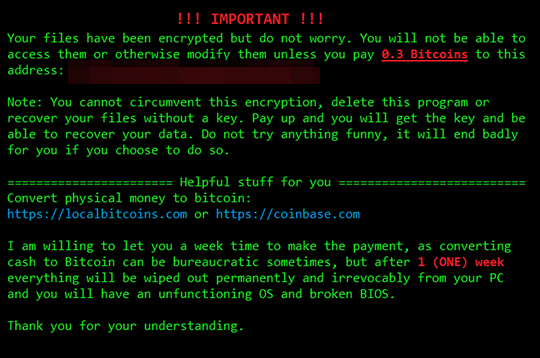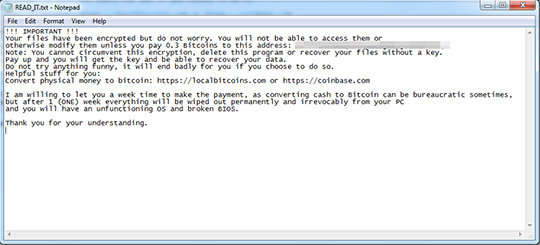RANSOM_HIDDENTEARSHAMZ.A
Ransom.HiddenTear(Malwarebytes)
Windows


Threat Type: Ransomware
Destructiveness: No
Encrypted: No
In the wild: Yes
OVERVIEW
This Ransomware arrives on a system as a file dropped by other malware or as a file downloaded unknowingly by users when visiting malicious sites.
TECHNICAL DETAILS
Arrival Details
This Ransomware arrives on a system as a file dropped by other malware or as a file downloaded unknowingly by users when visiting malicious sites.
Installation
This Ransomware drops the following copies of itself into the affected system and executes them:
- %User Profile%\acrobat.exe
(Note: %User Profile% is the current user's profile folder, which is usually C:\Documents and Settings\{user name} on Windows 2000, XP, and Server 2003, or C:\Users\{user name} on Windows Vista and 7.)
It drops the following files:
- %User Profile%\download_{machine name}-(username).txt - contains password used in the encryption
- %User Profile%\windows_diagnose.72y94k
- %User Temp%\wallpaper.bmp - set as Desktop wallpaper
- %Desktop%\READ_IT.txt - ransom note
(Note: %User Profile% is the current user's profile folder, which is usually C:\Documents and Settings\{user name} on Windows 2000, XP, and Server 2003, or C:\Users\{user name} on Windows Vista and 7.. %User Temp% is the user's temporary folder, where it usually is C:\Documents and Settings\{user name}\Local Settings\Temp on Windows 2000, Windows Server 2003, and Windows XP (32- and 64-bit); C:\Users\{user name}\AppData\Local\Temp on Windows Vista (32- and 64-bit), Windows 7 (32- and 64-bit), Windows 8 (32- and 64-bit), Windows 8.1 (32- and 64-bit), Windows Server 2008, and Windows Server 2012.. %Desktop% is the desktop folder, where it usually is C:\Documents and Settings\{user name}\Desktop in Windows 2000, Windows Server 2003, and Windows XP (32- and 64-bit); C:\Users\{user name}\Desktop in Windows Vista (32- and 64-bit), Windows 7 (32- and 64-bit), Windows 8 (32- and 64-bit), Windows 8.1 (32- and 64-bit), Windows Server 2008, and Windows Server 2012.)
It drops and executes the following files:
- %Desktop%\decrypter.exe
(Note: %Desktop% is the desktop folder, where it usually is C:\Documents and Settings\{user name}\Desktop in Windows 2000, Windows Server 2003, and Windows XP (32- and 64-bit); C:\Users\{user name}\Desktop in Windows Vista (32- and 64-bit), Windows 7 (32- and 64-bit), Windows 8 (32- and 64-bit), Windows 8.1 (32- and 64-bit), Windows Server 2008, and Windows Server 2012.)
Other System Modifications
This Ransomware modifies the following registry entries:
HKEY_CURRENT_USER\Control Panel\Desktop
WallpaperStyle = 1
(Note: The default value data of the said registry entry is {user preference}.)
HKEY_CURRENT_USER\Control Panel\Desktop
TileWallpaper = 0
(Note: The default value data of the said registry entry is {user preference}.)
HKEY_CURRENT_USER\Control Panel\Desktop
Wallpaper = %User Temp%\wallpaper.bmp
Other Details
This Ransomware renames encrypted files using the following names:
- {original filename and extension}.locked
It does the following:
- It encrypts files in the following folders:
- %System Root%\Users\
This ransomware sets the system's desktop wallpaper to the following image:

- It avoids encrypting files with the following extensions:
- .72y94k
- .locked
NOTES:
The ransom note contains the following:

%Desktop%\decrypter.exe displays the following:

SOLUTION
Step 1
Before doing any scans, Windows XP, Windows Vista, and Windows 7 users must disable System Restore to allow full scanning of their computers.
Step 2
Note that not all files, folders, and registry keys and entries are installed on your computer during this malware's/spyware's/grayware's execution. This may be due to incomplete installation or other operating system conditions. If you do not find the same files/folders/registry information, please proceed to the next step.
Step 3
Restart in Safe Mode
Step 4
Restore this modified registry value
Important: Editing the Windows Registry incorrectly can lead to irreversible system malfunction. Please do this step only if you know how or you can ask assistance from your system administrator. Else, check this Microsoft article first before modifying your computer's registry.
- In HKEY_CURRENT_USER\Control Panel\Desktop
- From: WallpaperStyle = 1
To: WallpaperStyle = {user preference}
- From: WallpaperStyle = 1
- In HKEY_CURRENT_USER\Control Panel\Desktop
- From: TileWallpaper = 0
To: TileWallpaper = {user preference}
- From: TileWallpaper = 0
- In HKEY_CURRENT_USER\Control Panel\Desktop
- From: Wallpaper = %User Temp%\wallpaper.bmp
To: Wallpaper = {user preference}
- From: Wallpaper = %User Temp%\wallpaper.bmp
Step 5
Search and delete this file
- %Desktop%\decrypter.exe
- %User Profile%\download_{machine name}-(username).txt
- %User Profile%\windows_diagnose.72y94k
- %User Temp%\wallpaper.bmp
- %Desktop%\READ_IT.txt
Step 6
Restart in normal mode and scan your computer with your Trend Micro product for files detected as RANSOM_HIDDENTEARSHAMZ.A. If the detected files have already been cleaned, deleted, or quarantined by your Trend Micro product, no further step is required. You may opt to simply delete the quarantined files. Please check this Knowledge Base page for more information.
Step 7
Restore encrypted files from backup.
Did this description help? Tell us how we did.


